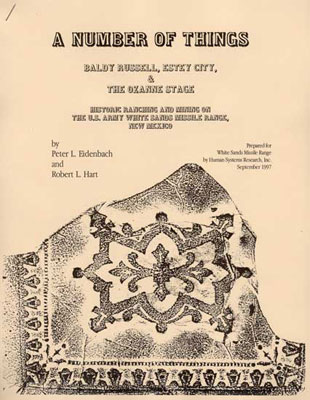


A Number of Things: Baldy Russell, Estey City, and the Ozanne Stage: Historic Ranching and Mining on the U.S. Army White Sands Missile Range, New Mexico
by Peter L. Eidenbach and Robert L. Hart
©1997 162 pages Out of Stock
A Number of Things results from continuing studies by Human Systems Research, Inc., on the late nineteenth century history of the northern Jornada del Muerto, Tularosa Basin, and Oscura Mountains of White Sands Missile Range, New Mexico.
This forbidding landscape was virtually uninhabited in the early 1890s when Bill Mitchell, alias Henry "Baldy" Russell, developed a series of hand-dug wells, establishing the first ranching homesteads in the area. At about the same time, miners began to explore the area, mail and stagecoach service connected the Rio Grande with the isolated settlements of the Sacramento and Sierra Blanca Mountains, and the brief cattle boom of the 1880s retreated to the grassy plains along the Rio Grande.
A Number of Things uses archaeological data and historic documents to tie together seemingly unrelated Baldy Russell, Estey City, and the Ozanne Stage. They are, simply, a number of decidedly interesting things from the past on today's White Sands Missile Range. Outlaw Baldy Russell wandered throughout this wilderness, providing the central theme, threading the contextual fabric of this little-known period. This theme weaves together West Texas, the source of many early ranch families; the first homesteads, several of which became the site for the Trinity atomic test in 1945; speculative mining ventures such as Estey City, which brought the railroad, ending the nineteenth and christening the twentieth century and displacing earlier, more romantic, frontier technologies like the Ozanne Stage.
Return to Publications




